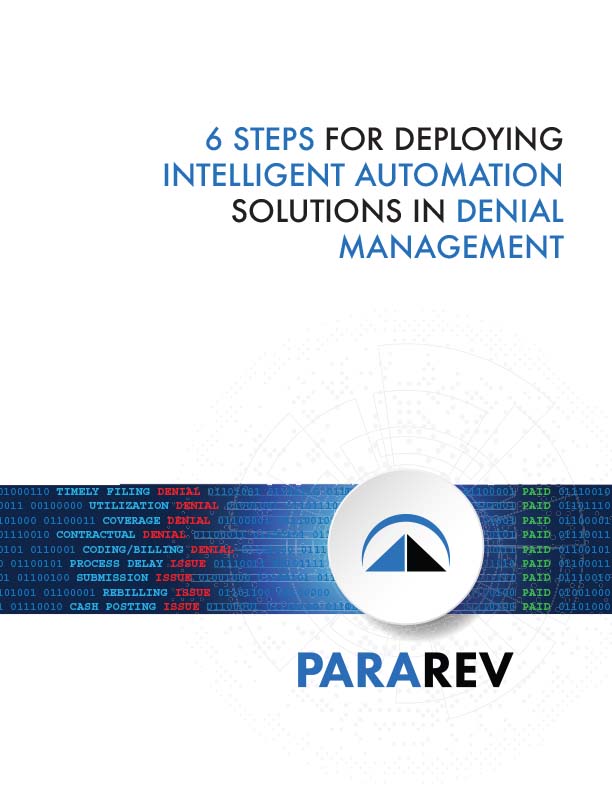The COVID-19 pandemic has had a dramatic impact on many providers’ revenue cycles, with sharply lower patient and procedure volumes triggering major cash flow problems across a range of organizations. Although the situation has stabilized for most, finding ways to reduce denials and ensure you’re paid every dollar you’re entitled has never been more important.
Denial Reality
Even before the pandemic, denials were a major and costly problem in healthcare. Consider:
- Denial volume increased by 79% for the average hospital between 2011 to 2017 [1]
- A recent survey of hospital executives found that 30% of responding facilities had bad debt of between $10 million and $50 million, while 6% reported bad debt of greater than $50 million [2]
- 9% of $3 trillion in U.S. hospital claims ($270 billion) were initially denied in 2016 [3]
- Hospitals expend $9 billion annually in administrative costs for rework denials [4]
- It takes 5-12 minutes per claim to check status manually [5]
- The average cost of each claim status check by providers is $5.40 [6]
Despite the growing prevalence of denials, the fact remains that 90% of claims are preventable and 66% are recoverable. Even so, 65% of claim denials are never corrected and resubmitted for reimbursement. [7]
Here are five ways to take control of your denial problem:
Step 1: Optimize the Effectiveness of Your Current AR Process
While hospitals continue to face rising accounts receivable (AR) balances due to denied, unpaid and underpaid commercial insurance claims, adding staff to pursue denials can be costly and may still result in many low-dollar, high-volume claims going unworked.
A virtual extension of your central billing office’s resources can help bolster your efforts with a dedicated, knowledgeable, and responsive team of experts who have specific experience with your payers. This additional capability, integrated seamlessly with your systems, can decrease cycle time, and help ensure all claims, no matter the age or balance, are effectively worked to 100% resolution.
Step 2: Develop a Hard Dollars Collection Strategy
An effective AR management strategy should incorporate processes to pursue claims at key aging intervals, so no denials fall through the cracks. Typically, hospitals can task their primary AR management firm with claims that have aged from 30 to 90 days before sending older claims to the pre-write-off insurance collection specialist. Alternatively, hospitals can task internal staff with new claims, then turn any remaining inventory over to a pre-write-off insurance collection vendor.
Ultimately, you want to develop a strategy to collect the extremely aged hard dollars or dollars already written off (zero balance) so that you can improve collections and verify that claims are truly uncollectable and may be removed from the balance sheet.
Step 3: Pursue Pre-write-Off Insurance Collection
Secondary assigned accounts or second placement AR services for pre-write-off insurance collections provide a critical safeguard to ensure no insurance payments legitimately due to the hospital go uncollected, regardless of age. The benefits of enlisting this kind of outsource capability include:
- The establishment of an AR management process that offers a systematic approach to obtaining 100% claims resolution
- A reduction in write-offs, a commensurate increase in cash flow and a decrease in bad debt reserves caused by aging accounts
- The creation of incentives that push primary AR vendors to optimize their processes
- Greater transparency to enable hospitals to evaluate performance across the entire revenue cycle

To learn more about reducing write-offs, click here.
Step 4: Conduct Zero-Balance Reviews
Specialized, forensic audits of written-off (zero balance) claims compare payments received to anticipated revenue based on episode-of-care specifics, coding best-practices, and payer-provider contractual terms. Any underpaid claims are resubmitted, per the payer’s terms, for reimbursement.
Recovered underpayments from zero-balance reviews can total up to 1% of a hospital’s annual Net Patient Revenue, an amount that may be significant for large hospitals and health systems that generate hundreds of millions of revenue annually. A zero-balance audit and recovery process should include training or education to help hospital staff mitigate systemic or reoccurring coding and process errors uncovered during the initial review.

Click here to learn more about how zero-balance claims reviews can be a critical backstop for AR management strategies
Step 5: Develop a Process to Identify the Root Cause of All Denials
No matter where collections are pursued in the revenue cycle, one of the most important steps you can take in developing a robust accounts receivable strategy is determining the root cause of delayed, underpaid or denied claims. Unfortunately, hospital personnel and many primary vendors frequently don’t have the time or technology to determine the precise underlying reason for the denial.
Partnering with a vendor that utilizes intelligent automation can help systematically isolate denials by type, age and size before all claims are worked to resolution. This time-saving process also helps identify exactly where in the revenue cycle the initial problem occurred so proactive measures can be taken to prevent it from happening again.

To learn 7 strategies for preventing up to 90% of denials, click here.
Protect Your Revenue
While it’s best to resolve and collect outstanding accounts receivable before they become highly aged, this isn’t always practical in today’s challenging reimbursement environment. By adopting a comprehensive and aggressive accounts receivable strategy to ensure hospitals receive all the money they’re due from payers, facilities can experience significant reductions in bad debt and write-offs and a corresponding increase in cash flow and margins.
Pararev can help you progress toward the goal of zero-percent write-offs through our comprehensive AR solutions. We’re able to resolve all claims, regardless of size or age quickly, and conduct zero-balance reviews to ensure you’re collecting every dollar you deserve. Contact us today to learn more.
- Kelly Gooch, “4 ways hospitals can lower claim denial rates,” Becker’s Hospital CFO Report, Jan. 5, 2018.
- “Bad Debt Exceeds $10M at a Third of Organizations, But Lack of Confidence Exists in How Much is Recoverable,” Cision PR Newswire. June 19, 2918.
- Philip Betbeze, “Claims Appeals Cost Hospitals Up to $8.6B Annually” HealthAffairs, March 16, 2021.
- ibid.
- ibid.
- ibid.
- Chris Wyatt, “Optimizing the Revenue Cycle Requires a Financially Integrated Network,” HFMA, July 7, 2015.

Overcoming the denial dilemma with intelligent automation. Learn how by downloading our whitepaper.


